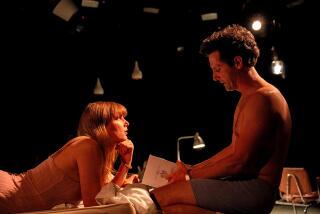Dance : American Indian Dance Troupe at the Wiltern
Against deep darkness, two dancers wearing helmetlike raven masks move onstage at the Wiltern Theatre, with Shiela Tousey in a black-and-red cape and Lloyd Yellowbird in one of black and green. Tracing tight semicircles, left and right, their hopping steps form a counterpoint to the slow circling of five bare-chested men in straw skirts way upstage.
Accompanied by rhythmic chants, this ceremonial dance of the Makah tribe from Neah Bay, Wash., is part of a remarkable new “Northwest Coast Suite” that both expands the range of American Indian Dance Theatre and helps the company achieve a daring artistic unity.
It begins with a group of dancers using paddles to row through liquid space. Later the group will boldly thrust spears in unison at unseen enemies or prey and then withdraw in a pitter-pat of tiny, almost delicate steps. In the “Sea Serpent Dance,” two masked dancers whirl in place, forward and back, shaking their heads. Meanwhile three others, unmasked and wearing shawls, bob rhythmically, arms circling across their torsos.
The contrast between weight thrust down into the floor and free-floating gestural motifs underpins many of these Makah dances, especially “The Sparrow Dance,” a quartet featuring springy footwork and the shivery pointing of hand-held long white feathers.
Launched by this varied yet dreamlike suite from the Pacific Northwest, the whole second half of the program becomes a kind of tone poem--mysterious, private, a bit mournful. Dances of the plains, pueblos and Far West reveal facets of the same feeling, with the central image, perhaps, being the intimate, soulful gestural benediction performed by Marty Pinnecoose, seated, accompanied by flute, in the “Memory Dance.”
Only at the very end does director Hanay Geiogamah return to the safety of a bravura showpiece: the “Fancy Dance Suite” with its solo virtuosity and costume spectacle. Otherwise, the company risks our incomprehension and even boredom to make a sustained, intuitive statement about something more essential to American Indian culture than variety of expression. Call it identity or a sense of oneness.
In previous seasons, American Indian Dance Theatre showed us dances of many tribes performed with great skill and taste. That achievement was historic, but now we’re taken inside many of the same dances and shown how they might belong to a single tribe.
This was always an important company, but in the factional ‘90s, it is becoming positively visionary. Happily, the level of solo artistry remains brilliant, with Eddie Swimmer’s hoop dance, as always, spectacular in its athleticism and mastery of sculptural image.
On Friday, however, George Shields and Morgan Tosee also looked fabulous in the intriguingly furtive confrontations of the “Shield Dance” and Tom Mauchauty Ware made his lyrical flute solo (spotlit against a night sky) into the apex of the company’s lush romanticism.
More to Read
The biggest entertainment stories
Get our big stories about Hollywood, film, television, music, arts, culture and more right in your inbox as soon as they publish.
You may occasionally receive promotional content from the Los Angeles Times.










